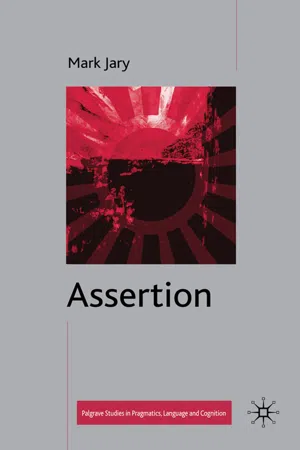Languages & Linguistics
Assertives
Assertives are a type of speech act that are used to make a statement or claim. They are characterized by the speaker's intention to convey a certain proposition as true or factual. In linguistics, assertives are studied as part of the broader field of pragmatics, which examines how language is used in context to achieve communicative goals.
Written by Perlego with AI-assistance
Related key terms
1 of 5
5 Key excerpts on "Assertives"
- eBook - PDF
- Carla Vergaro(Author)
- 2018(Publication Date)
- Peter Lang Group(Publisher)
47 Chapter 3. Assertive shell nouns 3.1 Introduction Assertive shell nouns report speech acts that, following Searle (1976: 10–11), share the illocutionary point or purpose of committing the speaker (in varying degrees) to the truth of the expressed proposition. The psychological state expressed by an assertive is Belief (that p), and the direction of fit is words to world. Commitment – association of belief, truth and knowledge – is graded and may approach or even reach zero. Example (1) illustrates this type of noun and the construction in which it occurs. (1) There is truth in the assertion that the Report received wide external attention by both the scholarly and the official communities. Pattern: noun followed by that-clause (N-that) Assertive speech acts are particularly important because, though the argument for the unmarked status of informative speech acts is quite complex (see Givón 1990), they are especially salient in discourse genres that represent the human-universal norm, and they predominate in terms of frequency (Givón 1990: 779; Watson 2004: 57; Green 2013: 387; Green 2017: 1). They are not only distinctive for the reasons mentioned above; ways of asserting are also distinctively sophisticated, and the differences between them are subtle and not easy to pin down. Therefore, assertive speech acts – their nature and norms – have been the topic of much research, especially from the philosophical point of view, with the speech act of assertion that plays the lion’s share, alone and in comparison with other members of the family 1 . Given the aim of the present research, we will refer very selectively to the philosophically oriented studies on assertive speech acts that are considered relevant for 1 See Goldberg (2015) for recent philosophical reflections on assertions. See instead section 3.3.1 for descriptive studies on single speech acts. 48 our research, and then move to the linguistic ones on the corresponding verbs and nouns. - eBook - PDF
- Klaus P. Schneider(Author)
- 2012(Publication Date)
- De Gruyter(Publisher)
215 5.5. Assertive acts 5.5.1. Interactional characterisation Searle's (1976) criterion 'direction of fit' can be used to distinguish between two funda-mental speech act classes, viz. directives and commissives on the one hand ('world-to-words') and Assertives on the other hand ('words-to-world'). 69 Unlike directives and com-missives, Assertives do not refer to a future action by either hearer or speaker (or both). Rather, the purpose of Assertives is to transmit information about a state of affairs. According to Leech (1983), Assertives are governed by more politeness maxims than any òf the other fundamental speech act classes. While the maxims of tact and generosity, which operate on the cost-benefit scale, apply to directive and commissive acts, the maxims of approbation and modesty, which operate on the praise-dispraise scale, apply to expres-sive and assertive acts. In addition to this latter scale, Assertives are governed by the max-ims of agreement and sympathy which refer to the unipolar scales. Therefore, in realising an assertive act, speakers must consider various social values. Polite speakers are expected to minimise praise of self and dispraise of other as well as disagreement and antipathy be-tween self and other, and to maximise praise of other and dispraise of seif as well as agree-ment and sympathy between self and other. Of course, not all of these maxims are relevant to all Assertives in all situations. 5.5.2. Specification Following Edmondson and House (1981: 57ff. and 98), Assertives can be divided into two general categories called 'phatic informatives' and 'business informatives', which correlate with basic distinctions such as interactional versus transactional discourse (cf. R. Lakoff 1989). 70 Phatic informatives are subdivided into 'remarks' and 'discloses', and business informatives into 'tells' and 'opines'. Phatic informatives refer to the immediate situation. - eBook - PDF
- M. Jary(Author)
- 2010(Publication Date)
- Palgrave Macmillan(Publisher)
We would do well, then, to follow Sperber and Wilson (1986/1995: 181) and call an assertion that P which is intended to inform the hearer that P an ‘ordinary assertion’. This allows for the existence of unordinary assertions where there is no intention to inform the speaker of the proposition expressed, whilst also recognising that the informativeness is essential to an adequate characterisation of assertion. 2.2.2 The assertive family and direction of fit As well as being an act in its own right, assertion has also been viewed by speech-act theorists as prototypical of a group of illocutionary acts. It is clear that asserting is not distinct from, say, informing, remind- ing and complaining in the way that it is distinct from promising and ordering, and this observation underlies attempts within speech-act the- ory to taxomonise illocutionary acts. This practice was started by Austin (1962/1975: Lecture XII), and various alternative systems have since been proposed by, among others, Searle (1975/1979), Bach and Harnish (1979) and Alston (2000). Those who put forward such taxonomies generally take whatever fea- ture they see as central to assertion as a necessary condition for being a member of the group for which it serves as a prototype. Thus, to be 12 Assertion member of Searle’s group of Assertives, an illocutionary act must count as an undertaking to the truth of the proposition expressed by the utter- ance (1975/1979: 12), while to be a member of Bach and Harnish’s class of constatives, an act must express both a belief and an intention that the hearer ‘form (or continue to hold) a like belief’ (1979: 42). Members of the group then vary in a variety of ways, such as according to the strength of speaker commitment (e.g. guessing vs. insisting) or whether the speaker is responding to a query. Searle (1975/1979: 2–8) lists twelve criteria according to which speech acts might be classified, but considers three of these to be the most important. - eBook - PDF
- R. Campbell(Author)
- 2011(Publication Date)
- Palgrave Macmillan(Publisher)
By activating our growing linguistic repertoire, embedded within appropriate grammatical forms, we can refer to and describe those objects. Producing appropriate sounds and marks thus serves to direct our own self-conscious awareness, and that of others, towards phenomena which might, or might not, be present. 7.2 Identifying assertions When in the 1950s J.L. Austin drew attention to the significance of speech- acts, he focussed on those by which we bring about some new state of affairs – such as marrying, or naming a ship, bequeathing a watch, or betting sixpence [sic!] (Austin 1980). These, which he called ‘performative utterances’, he initially contrasted with what he called ‘constative utter- ances’. The latter were those utterances by which statements are made. He soon recognized, however, that a comprehensive theory of speech-acts has to include acts of assertion, since making a statement is also a case of performing a speech-act. 1 1. A terminological clarification. Unfortunately, as we noted in §2.3, philosophers use “statement” and “assertion” in many different and confusing ways. So, for the sake of clarity, I have chosen to use the word “ assertion” to refer to a kind of speech-act, and, in the first instance, a statement is what is asserted. The term “statement” is not, however, entirely felicitous. A simple argument of the form modus ponens, for example, is pro- pounded by uttering three sentences in the form: p; if p then q; therefore q. In the first, p is asserted, and so, given this terminology, is a statement. But in the second, p is not asserted; it occurs as part of a longer statement. Yet for the argument to be valid both occurrences of p need to be of the same kind. It seems that we have to admit unasserted statements. For this reason, some writers on philosophical logic prefer to use the term “proposition” instead of “statement”. But there is no consensus on the use of the term “proposition”. - eBook - ePub
- Stavros Assimakopoulos(Author)
- 2017(Publication Date)
- De Gruyter Mouton(Publisher)
section 4 , but, before I do so, I need to introduce some basic notions of speech act theory.3Basic notions of speech act theory
An early lesson from John L. Austin (1961, 1962) was that asserting that a certain state of affairs is real is one among many things we can do with utterances. We can get married, baptise a ship, promise to finish a paper, bet 20 euros that our favorite team will win the match, etc. John Searle (1969, 1975) developed Austin’ s insights into what is known as speech act theory, according to which, in a speech act, we should distinguish between its illocutionary force F and its propositional content p . In the right circumstances, the following utterances would share their propositional content but differ in illocutionary force:(9)John left the room .(10)[=3] I will leave the room [uttered by John].(11)John, leave the room!(12)I wish John would leave the room .The propositional content p contains John, a certain room, and the action of leaving the room at a particular time t .16 But each utterance constitutes a speech act with a different illocutionary force F that belongs to a different class of illocutionary act. According to Searle (1975), illocutionary points serve to build the taxonomy of speech acts into five classes: Assertives, commissives, directives, declaratives and expressives. Each illocutionary point determines a certain sincerity condition, a direction of fit,17 and certain conditions of satisfaction, that together with some other elements of the speech act like the preparatory conditions, the mode of achievement, or the degree of strength, determine the illocutionary force of the speech act.An assertion like (9) illustrates the assertive illocutionary point, which consists in representing a state of affairs as real. That’ s what the speaker minimally intends when making an assertion, according to speech act theory. Besides, the sincerity condition establishes that the speaker believes that the state of affairs is real, i.e. that the propositional content of the speech act is true. That’ s the mental state she expresses in producing a speech act with assertive illocutionary point. The direction of fit of an assertion is words-to-world (or downward, ↓
Index pages curate the most relevant extracts from our library of academic textbooks. They’ve been created using an in-house natural language model (NLM), each adding context and meaning to key research topics.




